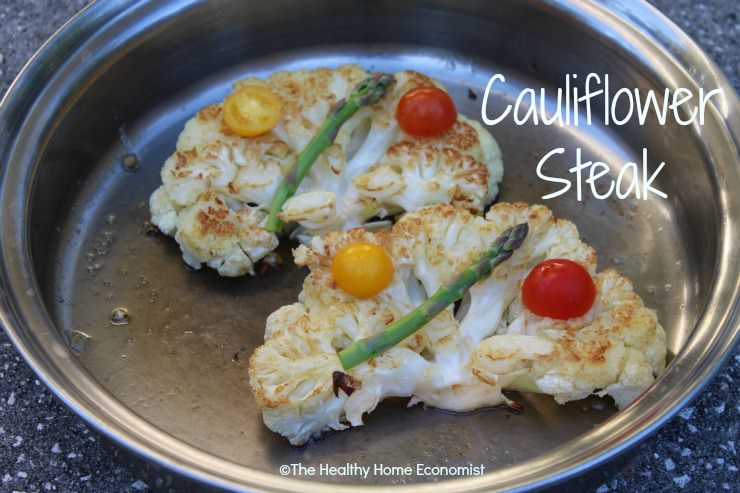Easy recipe for buttery, pan-fried cauliflower steak for those that enjoy meat but need to eat more vegetables without skimping on taste or nutrition. Great as a main course or side dish!

If your family loves steak but is a little light on the vegetables, try serving them cauliflower steak one night for dinner!
Cauliflower is one of the few vegetables that works very well as an all-natural veggie steak without all the additives, fillers and MSG of store-bought versions.
It is easily sliced into steak sized pieces without falling apart, and will quickly soften up and yet still retain adequate firmness whether you grill it on the patio or pan fry it in the kitchen.
Cauliflower is one of the cruciferous vegetables. Other veggies in that family include broccoli, kale, arugula, cabbage, collard greens, turnips, Brussels sprouts, and bok choy.
Why ALWAYS Cook Cauliflower?
The best way to cook cauliflower steak is in grass-fed or clarified butter. These healthy fats will not only impart the best flavor but will also supply your thyroid with organic iodine. All cruciferous vegetables contain thyroid-suppressing substances called goitrogens that pose little risk to healthy individuals when consumed within the context of an iodine-rich diet.
Another plus to cauliflower steak is that it is a cooked recipe, not raw. It’s true – not everything should be consumed raw!
Cooking cruciferous vegetables is important as it reduces these goitrogenic substances by up to two-thirds, depending on the cooking method used. Note that contrary to popular belief, fermentation does not reduce goitrogens in these veggies. However, since fermented crucifers such as sauerkraut are typically eaten as a condiment and, hence, in small amounts, consumption is fine when the diet is rich in iodine and no thyroid issues are present.
But what about the protective effect of cruciferous vegetables against colon cancer and other malignancies of the digestive tract? Aren’t the protective effects best obtained by eating them raw?
Crucifers Just as Anti-Cancer When Cooked!
Again, the answer is no.
Sulfur rich phytochemicals found in cruciferous veggies called glucosinolates do indeed have a strong anti-tumor effect but are only effective when they are converted to isothiocyanates (ITC). It was previously thought that cruciferous veggies had to be eaten raw for this to take place. This is because the glucosinolate-ITC conversion process requires the presence of the enzyme myrosinase which is destroyed during cooking.
However, an interesting study by The Fred Hutchinson Cancer Research Center has demonstrated that beneficial gut bacteria can do the work for us. Although heat destroys the enzyme myrosinase, consumption of cooked cruciferous vegetables actually stimulates the appropriate beneficial microbes in the gut that are able to convert glucosinolates into ITC instead.
Thus, you can still get all the colon cancer-fighting benefits of cauliflower and other cruciferous vegetables by cooking them which serves the dual purpose of significantly reducing thyroid-suppressing substances.
Nutritional Benefits
Cauliflower is certainly one of the tastiest vegetables readily available today. It is seasonally available in several colors including orange, purple, and green as well as the most common white florets. Feel free to serve your cauliflower in a rainbow of hues if you desire!

The many health and nutritional benefits of cauliflower include (1):
- Fights cancer: As mentioned earlier in this article, cruciferous vegetables like cauliflower contain sulfur-rich phytochemicals called glucosinolates which exert a strong anti-tumor effect.
- Antioxidants and phytonutrients: Cauliflower contains vitamin C, beta-carotene, and the antioxidants quercetin, rutin, cinnamic acid, among others. An adequate supply of natural, food-based antioxidants helps to overcome oxidative stress at the cellular level which can lead to premature aging, tissue and organ damage.
- Loaded with Minerals: Cauliflower is also a good source of magnesium, phosphorus, potassium, and manganese. Organic cauliflower grown in nutrient-rich soil would be highest in these minerals.
- Rich in B Vitamins: Cauliflower provides a wide array of B vitamins to the diet including thiamin (B1), riboflavin (B2), niacin (B3), pantothenic acid (B5), vitamin B6, folate (B9 – not to be confused with folic acid), and the brain-boosting nutrient choline.
- Good for the Heart: Cruciferous vegetables like cauliflower have been found to significantly improve blood pressure and kidney function. This is due to the presence of sulforaphane, which researchers believe helps improve DNA methylation, a critical function to protect cellular viability and normal gene expression especially within the delicate lining of the arteries.
- Anti-inflammatory: Lastly, cauliflower contains anti-inflammatory compounds like indole-3-carbinol (I3C). Early research suggests that it may help prevent inflammatory responses in the body at their most basic level.
How to Make Cauliflower Steak
Are you convinced yet that cauliflower steak would be a great addition to your family’s menu plan?
Below is a simple recipe to start you out with that can be used as a light main meal, a side dish for a real steak dinner, or topped with a fried egg. This third variation makes for a vegetarian “steak and eggs” dish!

Pan Fried Cauliflower Steak Recipe
This recipe for cauliflower steak is excellent if your family loves steak but needs to eat more vegetables without skimping on taste or nutrition. Great as main course or side dish.
Ingredients
- 1 large head of cauliflower preferably organic
- garnishing vegetables cherry tomatoes and asparagus suggested
- 2 Tbl grassfed butter or ghee
- 2 eggs optional
- sea salt
Instructions
-
Remove the leaves on the cauliflower head and trim the stem until it is flush with the creamy white florets (or green or purple depending on the color cauliflower you buy!).
-
With a large knife, cut 2-4 cauliflower steaks approximately 1 inch thick. See the picture above to get some idea of the shape and size.
-
Heat the butter or ghee in a large frying pan until melted and spread evenly across the pan. Carefully place the cauliflower steaks in the pan when hot. Cook for approximately 5 minutes each side on medium heat with the lid off. When cooking the second side, place sliced veggies for the garnish on top to warm and slightly soften them.
-
While the cauliflower steaks are grilling, fry up the optional free range eggs on a separate burner in another frying pan. Fry them either sunny side up or over hard depending on the preferences of those you will be serving.
-
Test the cauliflower steaks with a fork, and if they are soft, remove from the pan. If still quite firm, cook a few more minutes.
-
Remove from pan and place on serving platters. Top each cauliflower steak with garnishing vegetables and an optional fried egg as desired.
-
Serve immediately either as a side dish or as the main course paired with a salad for a lighter meal.









Love your way of thinking! Thanks for sharing.
oh my god this is so vegetables friendly : / i dont know if it’s healthy enough. for a main?? where do i get my proteins and iron. im so disappointed u sara. i need my dairy & meat!! do u think i could combine more sour cream & cheese on this?
The recipe says to put an egg or two on top if you want to 🙂
I made something like this yesterday and it was delicious. I didn’t know about pairing cruciferous veggies with grass fed butter to supply iodine! Thanks for the valuable info/// Would I get the benefit if I roasted my cauliflower in a little olive oil and then melted grass fed butter on top when serving?
Yes, that would work too!
I see the different colored cauliflower available seasonally in the US via veggie co-ops and also at the healthfood store. They taste delicious and are a nice change from the white versions.
Can’t define the temptation inside my mouth to have it. It must be delicious. Moreover, from where we can get these colored cauliflowers?